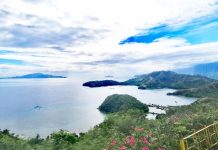by Milbie and Maya
BLUE, yellow, pink, and green motorboats rush across the deep, blue sea adding to the vibrant atmosphere on this early morning cruise in the Celebes Sea as I and my companions head toward the island we have heard so much about.
The sun beams over the unruffled sea that mirrors a cloudless sky. We lightly glide over the water going southward, the pleasant breeze cooling our skin. I am with Myra and Beverly, my pals since high school, and friendly Manuel who owns the blue motorboat we are on board of. Behind the wheel is Manong Miko, the navigator and captain of our motorboat.
He tells us that Tuka Marine Park lies 2.5 kilometers southwest of the poblacion of Kiamba, reachable only by a 20-minute boat ride. The early settlers of Kiamba called the park Tuka, for its figure resembles a bird’s beak called “tuka”(accent on the last syllable) in the local dialect.
Bordered by rocks, Tuka is divided into four curved sections: First Tuka, Second Tuka, Third Tuka, and Fourth Tuka.
As we move farther across the open sea, I turn to face our point of origin and hurriedly take several pictures capturing the scenery where talisay trees shade a picnic-perfect gazebo inside a children’s playground. Behind it stands the charming white town hall where the two men who a while ago were standing and smoking on the stairway are probably still in deep conversation.
I watch the playground fade slowly in the distance as the lush mountains that shelter the borough we are headed for come into clearer view. It is exhilarating seeing the one hundred year-old trees in the distance depicting a vivid image of untouched nature and stretched before it the entire Celebes Sea. Already I feel like I’m on the set of Survivor.
Manuel warns us of big waves far ahead as we sail westward to track Tuka. I put my camera back in its plastic case and hand it to him lest I accidentally drop it. Myra, Beverly and I scream and tremble as waves angrily slam against our motorboat. Amused, Manuel tells us to hold on tight. We need no prodding.
Anxiously we clasp each other and the boat, our hair playing with the wind, the seaspray wetting our bodies. Within minutes we spot the rock-strewn coast and in no time we are right in the middle of the First Tuka, approaching the shore.
The Deserted Coast
A welcoming ambiance of serenity and cold air greets us. Only the noise of the boat’s engine disturbs the solemnity of this deserted coast enhanced even more by the whisper of the wind and the sound of waves breaking on the rocky shore.
I spit into my snorkeling mask and spread the saliva to its corners. Now that it’s clean, I jump into the water with Myra and Beverly in tow. We put on our masks and float around in the sparkling blue-green water awed by our first breath-taking sight of corals, crustaceans, and fishes we had until then only admired on the National Geographic Channel.
There are jagged-looking corals that look like miniature tree limbs, some fan-shape, and pink and orange flowers. Several huge brain-like corals hug the seabed, their skin appearing to ripple and sway in the water like wary animals without eyes.
Striped fish, yellow fish, red fish, silver fish appear and disappear, smartly wriggling their bodies and zigzagging in all directions every time I try to touch them but in vain. That is because fish have a special sense organ called the lateral line to coordinate sudden turns and permitting the fish to feel the nearness of a predator and identify food or other fish.
The pebble-covered, sandy beach stretches away in the distance for about 600 meters. Over to one side I see a lush mountain without a single evidence that humans had once trod upon this part of the planet. Willowy palm trees cover the mountain and down to the very edge of the shore.
Fascinated, I tread inland, but seeing nothing of interest, I walk back to my waiting companions, happily aware that in this lifetime I have stepped foot on an island that hasn’t yet been violated by an expanding population. There are no cottages that mar the landscape, no cafes, spa salons, shower rooms. Not even toilets. There are no stores in sight or houses for that matter; no electric poles, no other people – just us. Our loud voices and laughter reach all the way to the mountainside and come echoing back to us.
Life-vests and snorkeling gadgets in hand, we stroll along the length of the pebbly shore to explore the whole coastline. I learn from Manuel that the local government of Kiamba intends to keep Tuka as a marine sanctuary, restricting anything that jeopardizes the bionetwork in this area. This is the reason why no facilities are constructed here and why visitors who come to Tuka to swim or enjoy a round of beach volleyball must bring containers in which to keep their trash for disposal elsewhere.
Tuka has in fact been declared a protected area by the local government. It has a total of 12 hectares core zone that is exclusively for research and study by environmental scientists and marine biologists who come here to collect stones and observe the biodiversity. Even fishers are prohibited from fishing in its waters in order to let fish spawn in peace.
I linger for a moment taking in the exotic surroundings. It is obvious to me now why Tuka, unlike so many other places, has to be kept in its natural charm. Simplicity and serenity are its very essence that detach it from our hustle-bustle world. For indeed Tuka could never have become an underwater haven if it were polished into a sophisticated resort people flock to every weekend. Let cities grow and countrysides develop but leave Tuka be, a precious pearl lying safely in its shell, unaffected by humanity.


